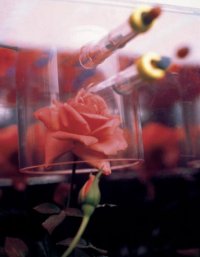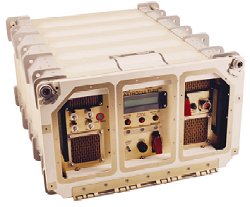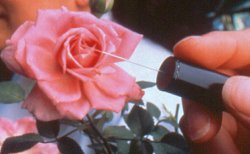|
Researchers hunting for new and profitable
perfume fragrances will soon send a pair of flowers into Earth orbit.
by Karen Miller and Dr Tony
Phillips
"That which we call a rose, by any
other name would smell as sweet."
Shakespeare knew a few things about
romance ... and roses. But here's something he never considered:
roses in space. Would they smell as sweet in Earth orbit?
It's not as silly as it sounds - at
least perfume industry giant International Flavours& Fragrances
(IFF) didn't think so. New perfume ragrances are much sought after
in the competitive perfume industry. Some years ago IFF researchers
began to wonder, Could space-travelling flowers
yield something new and exotic? The answer might prove profitable,
they figured.
And so began perhaps the most romantic
space experiment ever done.
In 1998, IFF teamed with the
Wisconsin Centre for Space Automation and Robotics (WCSAR),
a NASA Commercial Space Centre (CSC) at the University of Wisconsin.
WCSAR's job is to help companies research new products in space.
NASA's Space Product Development program at the Marshall Space Flight
Centre supports 15 such CSC's around the country.
WCSAR researchers had developed a plant
growth chamber called ASTROCULTURETM for the middeck
of the space shuttle. It provides plants with the appropriate temperature,
humidity, light, and nutrients during spaceflight, explains Dr.
Weijia Zhou, WCSAR director. ASTROCULTURETM was perfect
for IFF's purpose, and so on Oct. 28, 1998, a tiny rose selected
by IFF was able to leave Earth for a 10-day flight onboard the shuttle
Discovery (STS-95).

Credit: International Flavours
and Fragrances.
This miniature
rose called "Overnight Scentsation" was cultivated by IFF
researcher Dr. Braja Mookherjee for experiments in space.
|
IFF researchers quickly learned that
what we call a rose does indeed smell sweet in space ... but it
does not smell the same.
Here's why:
Fragrance, in flowers, is a variable
and elusive commodity, evolved solely to help plants reproduce by
attracting the insects and animals they need to spread their pollen,
or sperm, around. Although we tend to think of floral smells as
sweet and appealing, flowers produce a variety of odours, depending
on the preferences of their pollinators. If bees are lured by the
same kinds of smells that we like, carrion flies, for example, may
be drawn by ranker odours, like that of skunk cabbage.
But whatever they smell like, the odours
themselves come from "volatile oils," also known as essential oils,
because they carry the essential fragrance of the plant. These highly
concentrated plant extracts all share certain traits: For example,
they readily bind to receptors in olfactory neurons. They also tend
to be soluble in alcohol, but not water, and they often feel oily.
Most important is that they evaporate at room temperature. Indeed,
the fragrances used in perfumes are classified on a scale from 1
to 100, according to how readily they dissipate.
A plant's production of volatile oils
is strongly affected by its environment, explained Dr. Braja Mookherjee,
who, until his recent death, was Director of Global Natural Products
at IFF. Some plants, for example, produce more oils at night when
their pollinator is active, and some produce more in the daytime.
Temperature, humidity, and the age of the flower are influential,
too.
It's no wonder, said Mookherjee, that
low-gravity should affect a flower's smell just as other environmental
factors do.
The flower that flew on STS-95 was
a miniature rose called "Overnight Scentsation" - a plant no more
than seven inches high, with two buds just ready to open. The rose
needed to be small to fit inside ASTROCULTURETM, which
is a 17 by 9 by 21 inch enclosure.
"Ninety-nine percent of miniature roses
have no odour," said Mookherjee, but Overnight Scentsation is an
exception. It emits a fragrance, which Mookherjee described as "a
very green, fresh rosy note."

more
The ASTROCULTURETM
plant
growth chamber.
|
In low gravity, said Mookherjee, the
rose actually produced fewer volatiles than it did on Earth. But
the fragrance that it did generate was critically altered. The flower
in space had a more "floral rose aroma," which is aesthetically
pleasing.
And, no, the astronauts didn't just
sniff the flower.
To collect the scent, they reached
into the ASTROCULTURETM chamber and touched the rose
using a tiny silicon fiber. Less than one centimetre long, and only
1 to 2 millimetres in diameter, the fiber was coated with a special
liquid to which molecules around the flower petal adhere. After
the shuttle returned to Earth, IFF researchers took the fiber and
analysed the molecules they found on it.
"We identify the constituents, we know
the quantity, and then we can synthesize [the fragrance] here in
the lab," explained Mookherjee. The fragrance of a rose is made
up of nearly 200 different compounds, he added.

Credit: International Flavours& Fragrances
A lab technician
demonstrates the use of a silicon fiber to collect scent-molecules
from a rose.
|
The rose was sampled four times throughout
the STS-95 shuttle mission. Each time, says Mookherjee, they got
a different result. The scent that they finally arrived at was the
average of those samplings, and the new fragrance has since been
incorporated into "Zen", a perfume produced by the Japanese company
Shiseido.
The collaboration between IFF and WCSAR
will continue on STS-107, a shuttle mission slated for launch in
January 2003. This time the plan is to send up two different
plants - a rose and an Asian rice flower - again placed in the ASTROCULTURETM
facility. Like Romeo and Juliet, the flowers will touch each other.
This as well as the low gravity, said Mookherjee, will alter the
molecules they emit.
The ability to do research in space,
concluded Mookherjee, gives a whole new dimension to the field of
fragrance studies. "It's a fantastic opportunity," he said ...one
that the Bard himself might have appreciated.
|
